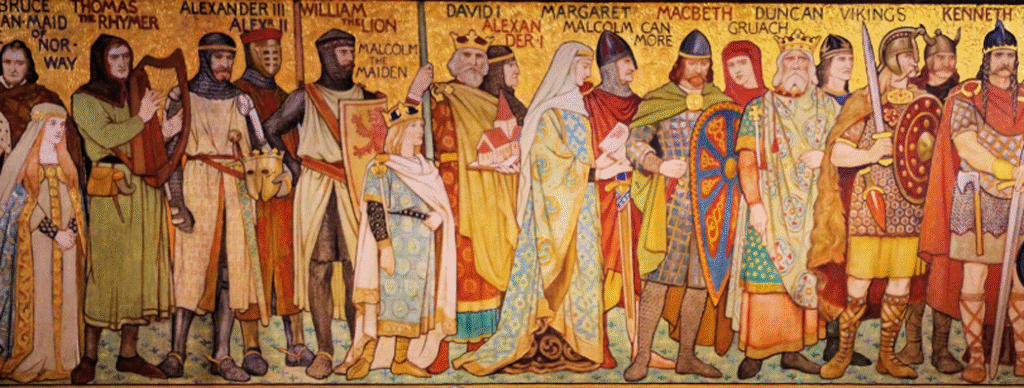SCOTLAND IN THE EARLY MIDDLE AGES

In 1124, David I mac Maíl Choluim united Alba (the north), Cumbria, and Lothian as one nation under a single set of laws called the Law of the Brets and Scots, which remained in force until 1305.
David I or Dauíd mac Maíl Choluim (Modern Gaelic: Daibhidh I mac [Mhaoil] Chaluim; c. 1084 – 24 May 1153) was a 12th century ruler and saint who was Prince of the Cumbrians from 1113 to 1124 and King of Scotland from 1124 to 1153. The youngest son of King Malcolm III and Queen Margaret, David spent most of his childhood in Scotland but was exiled to England temporarily in 1093. Perhaps after 1100, he became a dependent at the court of King Henry I of England, by whom he was influenced.
Think of this as a panoramic picture taken with time-lapse photography of the geographic, political, and ecclesiastical divisions into which Scotland was divided throughout the 12th century, or more accurately, from the late 11th century through the end of the reign of William the Lyon.
William the Lion (Scottish Gaelic: Uilleam an Leòmhann), sometimes styled William I (Uilleam MacEanraig; Medieval Gaelic: Uilliam mac Eanric) and also known by the nickname Garbh, ‘the Rough’ (c. 1142 – 4 December 1214), reigned as King of Alba from 1165 to 1214. His almost 49-year-long reign was the longest for a Scottish monarch before the Union of the Crowns in 1603.
The purpose here is not so much a detailed verbal map of the Scottish landscape as it is an almost motion picture illustrating the changing society over a little more than a century.
Interesting historical fact:
Though responsible for the greatest upsurge, David I was not the first king of Alba or of the Brets and Scots to import Norman knights.
No, that was Macbeth mac Findlaech, king of Moray and king of Alba, scion of the line of Oengus I mac Fergus.
What I refer to as provinces below are entities constituting multiple districts, either those into which the kingdoms that became Scotland were divided or else how they came into Scotland grouped together.
In this case, geography is more important than politics, so, for example, the mainland provinces of:
- Garmoran
- Lorn
- Argyll
are restricted to their mainland territories while the South (or Western) Isles, also known as the Hebrides, are listed separately.
I have consulted nearly 450 sources to put this together, but I’m not listing them because this is a blog post and a pretty damn long one already.
While doing this, I learned of several provinces of which I had no knowledge before.
The provinces are designated by whatever title under which they appear in the historical record or under which they were absorbed into the kingdom.
Therefore, we have:
- mormaerdoms
- earldoms
- several lordships
- one jarldom
- one principality
and a couple I have just designated simply “province”.
Most have the title before them under which they first appeared.
